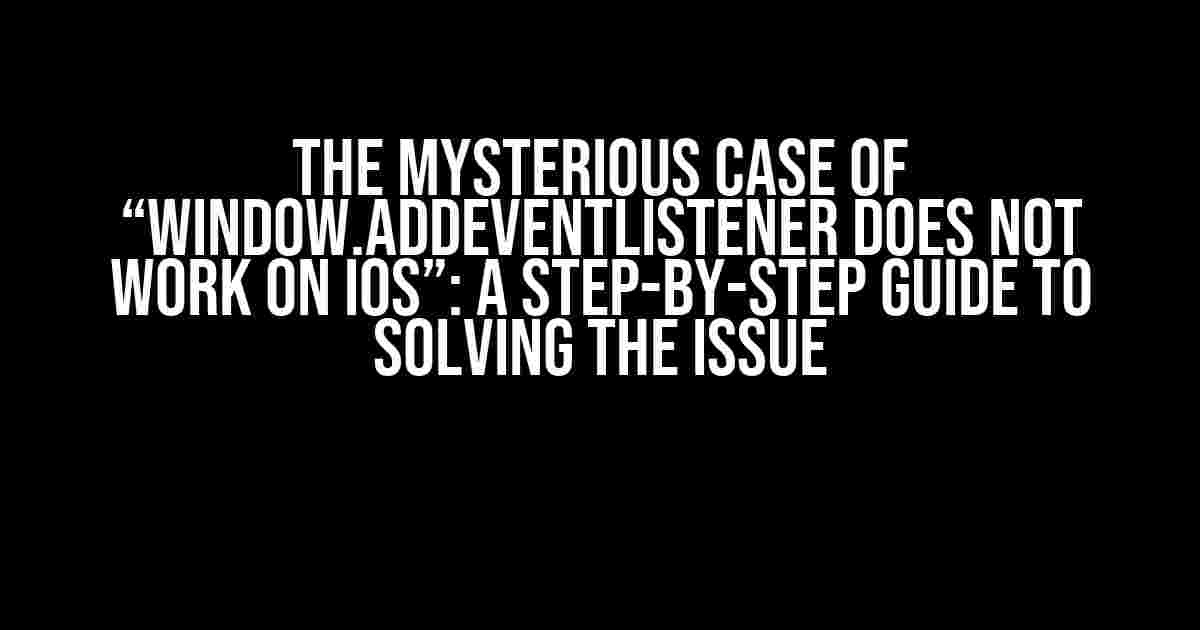Hey there, fellow developers! Have you ever encountered the frustrating error “window.addEventListener does not work on iOS”? You’re not alone! This pesky issue has been plaguing developers for years, leaving many scratching their heads and wondering why their code refuses to work on Apple devices. Fear not, dear reader, for we’re about to embark on a thrilling adventure to conquer this problem once and for all!
What’s the Deal with window.addEventListener?
window.addEventListener is a fundamental method in JavaScript that allows us to attach event listeners to elements on a webpage. It’s used to capture user interactions, such as clicks, taps, and scrolling, and is an essential tool in every web developer’s toolkit. So, why does it refuse to work on iOS devices?
The Culprit: Safari’s Quirks and iOS’s Restrictions
The root of the problem lies in Safari’s implementation of event listeners and iOS’s strict security policies. On iOS devices, Safari runs in a sandboxed environment, which limits the access to certain events and functionalities. This sandboxing is designed to enhance security and protect users from malicious activities, but it also means that our beloved window.addEventListener might not work as expected.
Common Scenarios Where window.addEventListener Fails on iOS
Before we dive into the solutions, let’s take a look at some common scenarios where window.addEventListener might not work on iOS:
- Attaching event listeners to the window object directly (e.g., window.addEventListener(‘scroll’, () => {}))
- Using event listeners on elements with
-webkit-overflow-scrolling: touch;oroverflow: scroll; - Trying to capture events on iOS-specific elements, such as the address bar or navigation buttons
- Using deprecated or non-standard events, like
DOMMouseScrollormousewheel
Solutions to Get window.addEventListener Working on iOS
Now that we’ve identified the culprits, let’s explore the solutions to get window.addEventListener working on iOS:
1. Use document.addEventListener Instead
A simple yet effective workaround is to attach event listeners to the document object instead of the window object:
document.addEventListener('scroll', () => {
// Your code here
});This approach works because the document object is not subject to the same sandboxing restrictions as the window object.
2. Add Event Listeners to a Container Element
Another solution is to attach event listeners to a container element that wraps your content, such as a div or section:
<div id="container"></div>
// JavaScript
const container = document.getElementById('container');
container.addEventListener('scroll', () => {
// Your code here
});This approach ensures that the event listener is attached to an element that is not restricted by iOS’s sandboxing.
3. Use iOS-Specific Workarounds for Scroll Events
For scroll events, you can use the touchmove event as a fallback on iOS devices:
document.addEventListener('scroll', () => {
// Your code here
}, { passive: true });
// Fallback for iOS
document.addEventListener('touchmove', () => {
// Your code here
}, { passive: true });The passive: true option is essential to ensure that the event listener doesn’t interfere with iOS’s native scrolling behavior.
4. Avoid Using Deprecated or Non-Standard Events
Make sure to use standard events that are supported across all modern browsers. Avoid using deprecated or non-standard events, such as DOMMouseScroll or mousewheel, which might not work on iOS devices:
// Avoid this
document.addEventListener('DOMMouseScroll', () => {
// Your code here
});
// Use this instead
document.addEventListener('wheel', () => {
// Your code here
});Bonus Tips and Tricks
To ensure that your event listeners work seamlessly across all devices, including iOS:
- Use feature detection to check for touch events and adjust your code accordingly.
- Avoid using
e.preventDefault()ore.stopPropagation()without careful consideration, as they might interfere with iOS’s native behavior. - Test your code on various iOS versions and devices to ensure compatibility.
- Keep your event listeners concise and lightweight to prevent performance issues.
Conclusion
The “window.addEventListener does not work on iOS” conundrum is a frustrating but solvable problem. By understanding the underlying issues and implementing the solutions outlined in this article, you’ll be able to get your event listeners working smoothly on iOS devices. Remember to always keep your code flexible, adaptable, and optimized for the ever-changing landscape of web development.
| Safari Version | iOS Version | Window Event Listeners |
|---|---|---|
| Safari 13.1+ | iOS 13.4+ | Supported with workarounds |
| Safari 12.1+ | iOS 12.2+ | Supported with limitations |
| Safari 11.1+ | iOS 11.3+ | Not supported |
Stay curious, stay coding, and may the odds be ever in your favor!
Related Articles:
- “The Ultimate Guide to JavaScript Event Listeners”
- “Demystifying Safari’s Quirks and iOS’s Restrictions”
- “Cross-Browser Compatibility: A Developer’s Survival Guide”
Here are 5 Questions and Answers about “window.addEventListener does not work on iOS” :
Frequently Asked Question
iOS can be a bit finicky when it comes to JavaScript events. If you’re struggling to get window.addEventListener to work on iOS, you’re not alone! Here are some frequently asked questions to help you troubleshoot the issue.
Why doesn’t window.addEventListener work on iOS?
It’s not that window.addEventListener doesn’t work on iOS, it’s just that iOS has some unique requirements when it comes to handling touch events. By default, iOS ignores touch events on the window object, which means your addEventListener won’t be triggered. To fix this, you need to add a dummy event listener to the document.body or a container element to capture the touch events.
Do I need to use a specific event type on iOS?
Yes, on iOS, you need to use the “touchstart” event type instead of “click” or “mouseover”. This is because iOS uses a different event model than desktop browsers. By using “touchstart”, you can capture the touch event and respond accordingly.
Can I use jQuery to attach events on iOS?
While jQuery can make event handling easier, it’s not a silver bullet on iOS. jQuery’s event handling mechanism can still be affected by iOS’s quirks. To ensure compatibility, it’s best to use vanilla JavaScript and attach events directly to the element or use a library that’s specifically designed to handle iOS events, such as Hammer.js or FastClick.
How do I prevent scrolling on iOS when attaching events?
To prevent scrolling on iOS when attaching events, you can use the “touchmove” event and call preventDefault() on the event object. This will prevent the default scrolling behavior and allow your event handler to take over. You can also use a library like iScroll to handle scrolling and zooming on iOS.
Are there any workarounds for older iOS versions?
For older iOS versions (pre-iOS 9.3), you may need to use a workaround like attaching events to the document.body instead of the window object. You can also use a library like Sencha Touch or jQuery Mobile, which provide additional event handling mechanisms specifically designed for older iOS versions.
I hope these FAQs help you troubleshoot your window.addEventListener issues on iOS!



